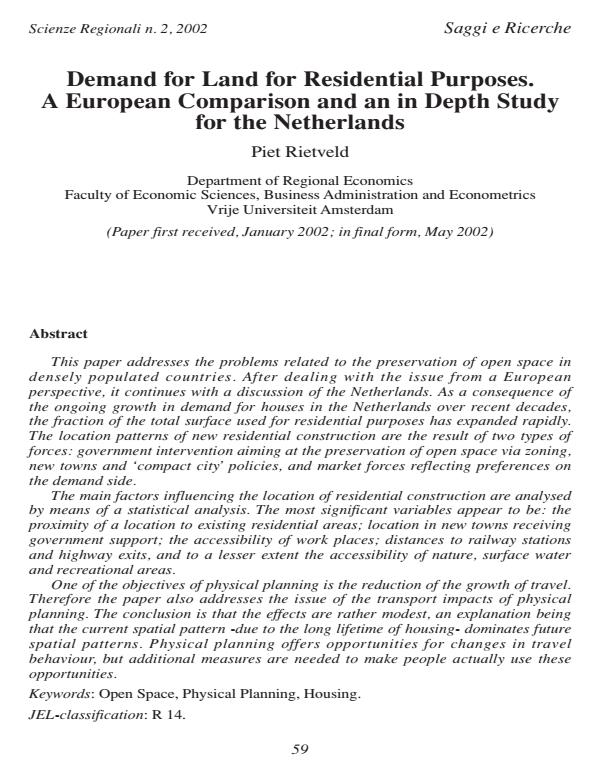Demand for Land Residential Purposes. A European Comparison and an in Depth Study for the Netherlands
Journal title SCIENZE REGIONALI
Author/s Piet Rietveld
Publishing Year 1 Issue 2002/2
Language English Pages 20 P. File size 131 KB
DOI
DOI is like a bar code for intellectual property: to have more infomation
click here
Below, you can see the article first page
If you want to buy this article in PDF format, you can do it, following the instructions to buy download credits

FrancoAngeli is member of Publishers International Linking Association, Inc (PILA), a not-for-profit association which run the CrossRef service enabling links to and from online scholarly content.
<i> Demand for Land Residential Purposes. A European Comparison and an in Depth Study for the Netherlands </i> (di Piet Rietveld) - ABSTRACT: This paper addresses the problems related to the preservation of open space in densely populated countries. After dealing with the issue from a European perspective, it continues with a discussion of the Netherlands. As a consequence of the ongoing growth in demand for houses in the Netherlands over recent decades, the fraction of the total surface used for residential purposes has expanded rapidly. The location patterns of new residential construction are the result of two types of forces: government intervention aiming at the preservation of open space via zoning, new towns and ‘compact city’ policies, and market forces reflecting preferences on the demand side. The main factors influencing the location of residential construction are analysed by means of a statistical analysis. The most significant variables appear to be: the proximity of a location to existing residential areas; location in new towns receiving government support; the accessibility of work places; distances to railway stations and highway exits, and to a lesser extent the accessibility of nature, surface water and recreational areas. One of the objectives of physical planning is the reduction of the growth of travel. Therefore the paper also addresses the issue of the transport impacts of physical planning. The conclusion is that the effects are rather modest, an explanation being that the current spatial pattern -due to the long lifetime of housing- dominates future spatial patterns. Physical planning offers opportunities for changes in travel behaviour, but additional measures are needed to make people actually use these opportunities.
Keywords: Open Space, Physical Planning, Housing
Jel codes: R 14
Piet Rietveld, Demand for Land Residential Purposes. A European Comparison and an in Depth Study for the Netherlands in "SCIENZE REGIONALI " 2/2002, pp , DOI: